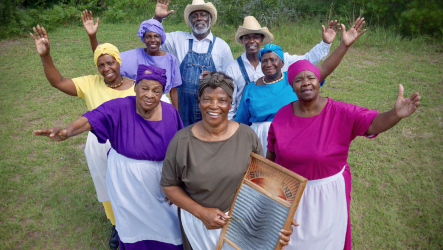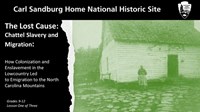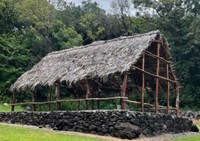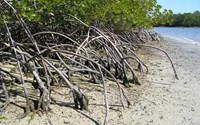- Lesson Plan (25)
- Science Labs (4)
- Student Activities (2)
- New Orleans Jazz National Historical Park (6)
- Palo Alto Battlefield National Historical Park (3)
- Carl Sandburg Home National Historic Site (2)
- Bent's Old Fort National Historic Site (1)
- Blackstone River Valley National Historical Park (1)
- Cane River Creole National Historical Park (1)
- Castillo de San Marcos National Monument (1)
- Craters Of The Moon National Monument & Preserve (1)
- Cumberland Island National Seashore (1)
- Show More ...
- Social Studies (24)
- Literacy and Language Arts (15)
- Science (10)
- Math (3)
- 9-10.RH.2 (9)
- 9-10.RH.1 (8)
- 6-8.RH.2 (7)
- 9-10.RH.4 (7)
- 6-8.RH.1 (6)
- 6-8.RH.10 (5)
- 9-10.RH.10 (5)
- 9-10.RH.3 (5)
- 9-10.RH.7 (5)
- Show More ...
Showing 31 results for laborers ...
Trading Post Labor
- Type: Lesson Plan
- Grade Levels: Upper Elementary: Third Grade through Fifth Grade
Lewis Garrard's ten-month journey on the Santa Fe Trail produced a collection of observations that include the multicultural nature of labor in the southwestern borderlands in the 1840s. This lesson offers an opportunity to analyze the Bent, St. Vrain, & Company's dependence on skilled labor from various classes, ethnicities, and national origins.
The Sharecroppers, Tenant Farmers, and Day Laborers
- Type: Lesson Plan
- Grade Levels: Middle School: Sixth Grade through Eighth Grade

In this interactive lesson plan, students will explore the economic hardships and challenges for those who worked as sharecroppers, tenant farmers, and day laborers. Student groups will each follow the life of one person for a year - tracking their expenditures, and balancing their budget at the end of the season.
- Type: Lesson Plan
- Grade Levels: High School: Ninth Grade through Twelfth Grade
The Bean Lab: Elementary Lesson
Snow Characteristics Lab Activity
- Type: Science Labs
- Grade Levels: Upper Elementary: Third Grade through Fifth Grade
In this science lab activity, students take temperatures at different depths in the snow and compare them to the air temperature. They will discover the insulating effect of snow and understand that temperature varies according to snow depth.
Floodwaters in the Desert Lab Activity
- Type: Lesson Plan
- Grade Levels: Upper Elementary: Third Grade through Fifth Grade

Students will explore precipitation through discussion, videos, and a PowerPoint presentation. For the lab activity, students will explore the way flood waters can affect the landscape and topography in the desert. Students will observe what happens to the landscape as different amounts of water are dropped on the hillside.
He Aha Lā He Kūkulu?
National Park Labs: Studies of Wildland Fire Ecology
- Type: Science Labs
- Grade Levels: High School: Ninth Grade through Twelfth Grade

National Park Labs: Studies of Wildland Fire Ecology curriculum is progressive and builds on the knowledge of each prior lesson. Teacher materials include guidelines that provide the concept, objective, method, materials, duration, procedures for conducting lessons, student handouts, and student investigation worksheets.
"Mangrove Propagule Lab" Habitat Video: Florida Bay
- Type: Lesson Plan
- Grade Levels: Middle School: Sixth Grade through Eighth Grade

Students will understand how Sandburg used poetry to express his opinion on important events of his time such as labor rights and child labor laws. The students will use historic photographs to analyze some of Sandburg’s Chicago poems. Students will answer questions about the poems to demonstrate their understanding. (This lesson could also be used for high school.)
Problems and Perspectives (Grades 9-12) Carl Sandburg Home NHS
“Little Mexico” and Creating Community
- Type: Lesson Plan
- Grade Levels: High School: Ninth Grade through Twelfth Grade
Ladders for Success
- Type: Lesson Plan
- Grade Levels: Upper Elementary: Third Grade through Fifth Grade

Your 4th graders will learn about the number of family members and community members it took to farm, get water, chop and deliver wood for the fire pits and other daily tasks. They will discuss the labor intensive chore of making a ladder, and then make their own mini version to see how it was done.
- Type: Lesson Plan
- Grade Levels: Middle School: Sixth Grade through Eighth Grade

The Gullah Geechee are African Americans with ancestral roots in the Southeastern U.S., from southeastern North Carolina all the way down to northeastern Florida. Their ancestors, taken from West and Central Africa between the early 1600s and the 1850s, were forced into labor due to their skills and strength. To preserve their heritage, they created the Gullah Geechee language by blending native African languages with English.
Considering Climate Change: Fire Island and Storms
- Type: Science Labs
- Grade Levels: High School: Ninth Grade through Twelfth Grade

This science lab explores the impacts of Hurricane Sandy - the history-making 2012 storm - on the natural resources of Fire Island, and challenges students to consider the effects of climate change that are likely to occur close to home. It is an inquiry-based lab with pre-labs, activities, and homework designed to increase understanding of climate change.
The Lost Cause: Colonization, Chattel Slavery, and Migration (Grades 9-12) Lesson 1 of 3 Carl Sandburg Home NHS
- Type: Lesson Plan
- Grade Levels: High School: Ninth Grade through Twelfth Grade

This lesson addresses the migratory history of western North Carolina and the myths about the region. Migration from the South Carolina Lowlands to the mountains of western North Carolina created many racial, economic and spiritual changes for everyone in the region. Wealth brought new development along with increased hierarchical discrimination and social practices. As many summer homes were built there were far more enslaved and free laborers who made the migration possibl
- Type: Lesson Plan
- Grade Levels: High School: Ninth Grade through Twelfth Grade

This lesson will look at the impact of artificially created fertilizers on the quality of the soil, especially in comparison with natural compost. Students will begin by creating their own compost. The “Compost in a Bottle Lab” is a long-term lab that should be started 3-4 weeks prior to beginning this lesson. Try to time it so that this lesson comes at the time when students are collecting their last set of data on their compost. Students also create a presentation product.
- Type: Lesson Plan
- Grade Levels: High School: Ninth Grade through Twelfth Grade

Future Civil War Major General and President Ulysses S. Grant, started developing his leadership skills as a 2nd Lieutenant in the Battle of Resaca de la Palma. Grant’s Memoirs, written 39 years after the battle, mentioned his experience in the battle. Students review a primary and secondary document about the Battle of Resaca de la Palma. The primary document is part of Grant’s Memoirs. The secondary document is a lithograph of the Battle. Afterwards, they answer questions about the documents.
Gran Quivira: A Blending of Cultures in a Pueblo Indian Village
- Type: Lesson Plan
- Grade Levels: Middle School: Sixth Grade through Eighth Grade








